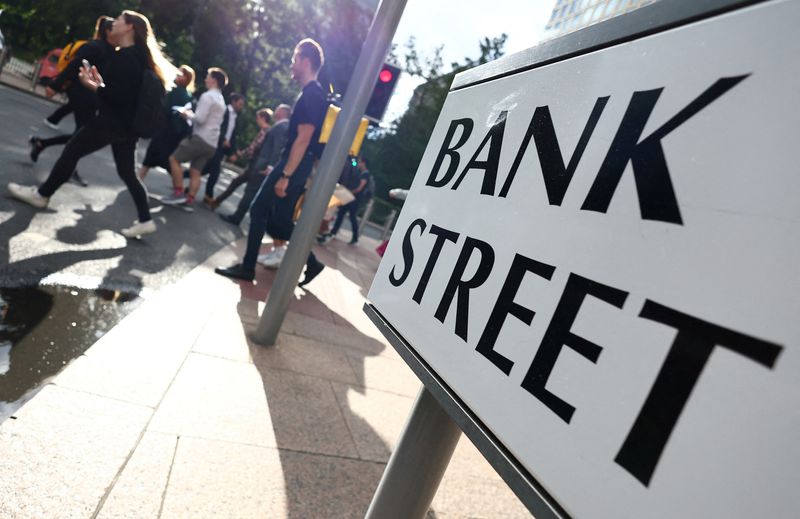Economy
Banks get carbon emissions standard they sought for stock, bond deals


© Reuters. FILE PHOTO: Workers walk past a street sign in the Canary Wharf financial district, ahead of a Bank of England decision on interest rate changes, in London, Britain, August 3, 2023. REUTERS/Toby Melville/File Photo
By Tommy Wilkes
LONDON (Reuters) -Banks will need to account for a third of the emissions linked to their capital markets deals when they report their carbon footprint, after an industry-led standard setter launched a long-awaited methodology on Friday.
Disagreement between banks over how much of the emissions should be apportioned to them delayed a decision, considered a crucial part of making emissions reporting credible.
The Partnership for Carbon Accounting Financials (PCAF), a voluntary group joined by dozens of financial institutions, had been trying since last year to finalise the standard for facilitated emissions – those generated by underwriting-related activities such as a lender helping a company issue a bond.
Pending the methodology, banks including Citi and Morgan Stanley have excluded the emissions from their reduction targets.
Environmental groups welcomed PCAF’s new standard, although ShareAction said it was disappointed banks would only have to account for 33% of the emissions linked to their capital markets businesses.
Reuters reported in July that banks working to develop the standard had voted to exclude the other two-thirds.
“Of course it wasn’t easy. Finding the number was complex. The most important objective of PCAF was to find a harmonising methodology that all banks can use,” PCAF Executive Director Angélica Afanador told Reuters.
Under the new standard, lenders have the option of disclosing 100% of their facilitated emissions as well as the 33% weighting.
Afanador said it was important to distinguish between banks as providers of capital via a loan kept on their balance sheets, and as facilitators for capital from investors in a stock or bond deal.
Banks signed up to PCAF must already account for 100% of the emissions from any financing that is kept on balance sheet – and so must investors for the emissions generated by the stocks and bonds they own.
UNDERWRITING FOSSIL FUELS
Two thirds of U.S. bank financing for fossil fuel expansion came via underwriting stocks and bonds, Sierra Club said in a July report.
“Banks have an enormous and overlooked climate impact from underwriting investments in big polluters, and disclosure of these impacts is long overdue,” said Adele Shraiman, senior strategist for the Sierra Club’s Fossil-Free Finance campaign.
Shraiman said PCAF’s standard provided a “baseline” for the industry to measure and disclose facilitated emissions, and that banks needed to set targets for reducing them and follow through on their pledges.
Jeanne Martin, Head of the Banking Programme at ShareAction, said PCAF had given banks a “get-out-of-transparency-free card” by using a 33% weighting.
“While we strongly welcome PCAF encouraging banks to go further, the guidelines published today are further proof that voluntary climate initiatives cannot deliver what is needed for people and planet,” she said.
In explaining its approach, Afanador said PCAF had decided on the 33% weighting because the Basel Committee on Banking Supervision, which assesses the importance of global systemically important banks (G-SIB), previously considered balance sheet exposures such as bank lending as three times more impactful than underwriting.
Not all big banks have joined PCAF.
Some have also developed their own methodologies for facilitated emissions, including JP Morgan, Goldman Sachs, Wells Fargo and Barclays.
PCAF’s new standard is designed for emissions from the bonds and stocks that are sold to investors. If the bank puts its own capital at risk when underwriting, it is treated differently.
For daily comprehensive coverage on COP28 in your inbox, sign up for the Reuters Sustainable Switch (NYSE:) newsletter here.
Economy
Russian central bank says it needs months to make sure CPI falling before rate cuts -RBC


© Reuters. Russian Central Bank Governor Elvira Nabiullina attends a news conference in Moscow, Russia June 14, 2019. REUTERS/Shamil Zhumatov/File Photo
MOSCOW (Reuters) – Russia’s central bank will need two to three months to make sure that inflation is steadily declining before taking any decision on interest rate cuts, the bank’s governor Elvira Nabiullina told RBC media on Sunday.
The central bank raised its key interest rate by 100 basis points to 16% earlier in December, hiking for the fifth consecutive meeting in response to stubborn inflation, and suggested that its tightening cycle was nearly over.
Nabiullina said it was not yet clear when exactly the regulator would start cutting rates, however.
“We really need to make sure that inflation is steadily decreasing, that these are not one-off factors that can affect the rate of price growth in a particular month,” she said.
Nabiullina said the bank was taking into account a wide range of indicators but primarily those that “characterize the stability of inflation”.
“This will take two or three months or more – it depends on how much the wide range of indicators that characterize sustainable inflation declines,” she said.
The bank will next convene to set its benchmark rate on Feb. 16.
The governor also said the bank should have started monetary policy tightening earlier than in July, when it embarked on the rate-hiking cycle.
Economy
China identifies second set of projects in $140 billion spending plan


© Reuters. FILE PHOTO: Workers walk past an under-construction area with completed office towers in the background, in Shenzhen’s Qianhai new district, Guangdong province, China August 25, 2023. REUTERS/David Kirton/File Photo
SHANGHAI (Reuters) – China’s top planning body said on Saturday it had identified a second batch of public investment projects, including flood control and disaster relief programmes, under a bond issuance and investment plan announced in October to boost the economy.
With the latest tranche, China has now earmarked more than 800 billion yuan of its 1 trillion yuan ($140 billion) in additional government bond issuance in the fourth quarter, as it focuses on fiscal steps to shore up the flagging economy.
The National Development and Reform Commission (NDRC) said in a statement on Saturday it had identified 9,600 projects with planned investment of more than 560 billion yuan.
China’s economy, the world’s second largest, is struggling to regain its footing post-COVID-19 as policymakers grapple with tepid consumer demand, weak exports, falling foreign investment and a deepening real estate crisis.
The 1 trillion yuan in additional bond issuance will widen China’s 2023 budget deficit ratio to around 3.8 percent from 3 percent, the state-run Xinhua news agency has said.
“Construction of the projects will improve China’s flood control system, emergency response mechanism and disaster relief capabilities, and better protect people’s lives and property, so it is very significant,” the NDRC said.
The agency said it will coordinate with other government bodies to make sure that funds are allocated speedily for investment and that high standards of quality are maintained in project construction.
($1 = 7.1315 renminbi)
Economy
Russian central bank says it needs months to make sure CPI falling before rate cuts -RBC


© Reuters. Russian Central Bank Governor Elvira Nabiullina attends a news conference in Moscow, Russia June 14, 2019. REUTERS/Shamil Zhumatov/File Photo
MOSCOW (Reuters) – Russia’s central bank will need two to three months to make sure that inflation is steadily declining before taking any decision on interest rate cuts, the bank’s governor Elvira Nabiullina told RBC media on Sunday.
The central bank raised its key interest rate by 100 basis points to 16% earlier in December, hiking for the fifth consecutive meeting in response to stubborn inflation, and suggested that its tightening cycle was nearly over.
Nabiullina said it was not yet clear when exactly the regulator would start cutting rates, however.
“We really need to make sure that inflation is steadily decreasing, that these are not one-off factors that can affect the rate of price growth in a particular month,” she said.
Nabiullina said the bank was taking into account a wide range of indicators but primarily those that “characterize the stability of inflation”.
“This will take two or three months or more – it depends on how much the wide range of indicators that characterize sustainable inflation declines,” she said.
The bank will next convene to set its benchmark rate on Feb. 16.
The governor also said the bank should have started monetary policy tightening earlier than in July, when it embarked on the rate-hiking cycle.

 Forex2 years ago
Forex2 years agoForex Today: the dollar is gaining strength amid gloomy sentiment at the start of the Fed’s week

 Forex2 years ago
Forex2 years agoHow is the Australian dollar doing today?

 Forex1 year ago
Forex1 year agoUnbiased review of Pocket Option broker

 Forex2 years ago
Forex2 years agoDollar to pound sterling exchange rate today: Pound plummeted to its lowest since 1985

 Cryptocurrency2 years ago
Cryptocurrency2 years agoWhat happened in the crypto market – current events today

 World2 years ago
World2 years agoWhy are modern video games an art form?

 Stock Markets2 years ago
Stock Markets2 years agoMorgan Stanley: bear market rally to continue

 Economy2 years ago
Economy2 years agoCrude oil tankers double in price due to EU anti-Russian sanctions

































